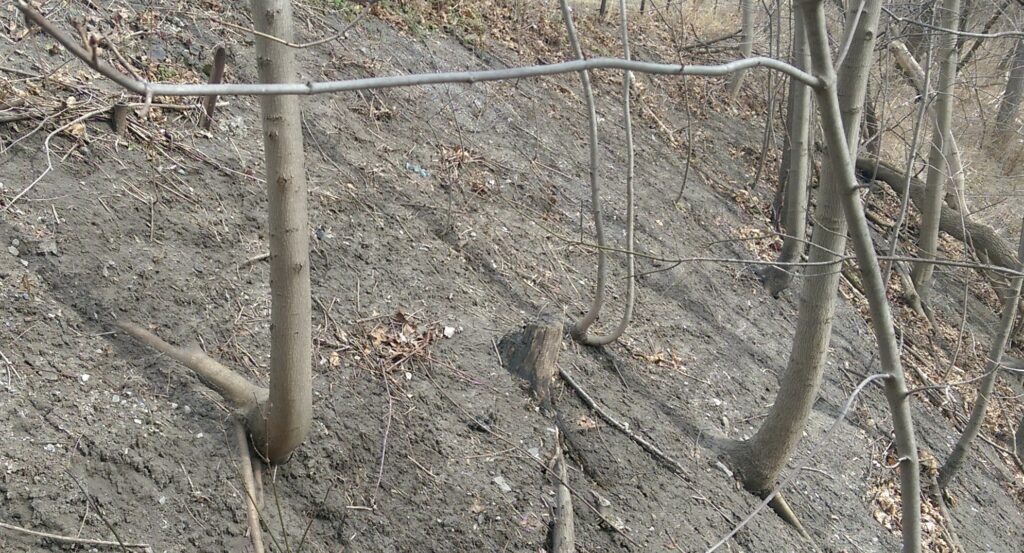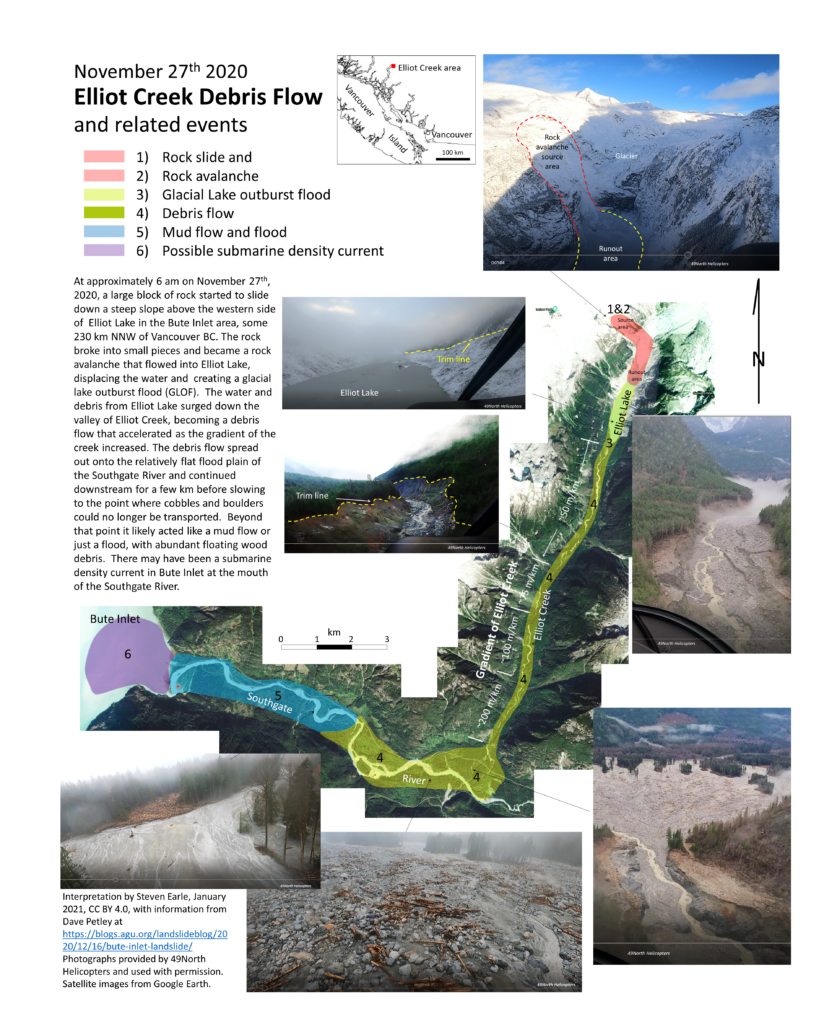5.2 Classification of Mass Wasting
Steve Earle
- The type of material that failed (typically either bedrock or unconsolidated sediment),
- The mechanism of the failure (how the material moved), and
- The rate at which it moved.
| Failure Type | Type of Material | Type of Motion | Rate of Motion |
| Rock fall | Rock fragments | Vertical or near-vertical fall (plus bouncing in many cases) | Very fast (>10s m/s) |
| Rock slide | A large rock body | Motion as a unit along a planar surface (translational sliding) | Typically very slow (mm/y to cm/y), but some can be faster |
| Rock avalanche | A rock body that slides and then breaks into small fragments | Flow At high speeds the mass of rock fragments is suspended on a cushion of air. | Very fast (>10s m/s) |
| Creep or solifluction | Soil or other overburden, in some cases mixed with ice | Flow (although sliding motion may also occur) | Very slow (mm/y to cm/y) |
| Slump | Thick deposits (m to 10s of m) of unconsolidated sediment | Motion as a unit along a curved surface (rotational sliding) | Slow (cm/y to m/y) |
| Mud flow | Loose sediment with a significant component of silt and clay | Flow (a mixture of sediment and water moves down a channel) | Moderate to fast (cm/s to m/s) |
| Debris flow | Sand, gravel and larger fragments | Flow (similar to a mud flow, but typically faster) | Fast (m/s) |
Rock Fall
Rock fragments can break off relatively easily from steep bedrock slopes, most commonly due to frost-wedging in areas where there are many freeze-thaw cycles per year. If you’ve ever hiked along a steep mountain trail on a cool morning you might have heard the occasional fall of rock fragments onto a talus slope as the sun melts the ice, releasing rock fragments that had been wedged out the night before. This process is illustrated in Figure 5.1.6 above.
A typical talus slope, near to Keremeos in southern BC, is shown on Figure 5.2.1. In December 2014 a large block of rock split away from a cliff in this same area. It broke into smaller pieces, which fell and tumbled down the slope and crashed into the road, smashing the concrete barriers and gouging out large parts of the pavement.
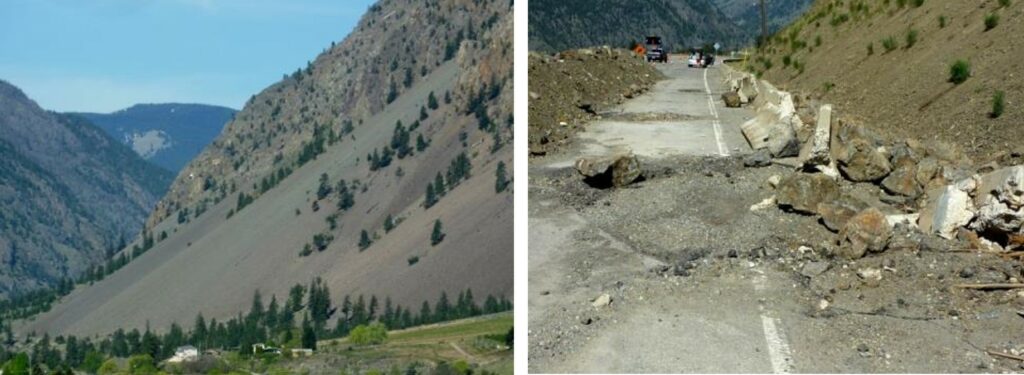
Rock Slide
A rock slide is the sliding motion of rock along a sloping surface. In most cases the movement is parallel to a fracture, bedding plane or metamorphic foliation plane, and it can range from very slow to moderately fast. The word sackung describes the very slow motion of a block of rock (mm/y to cm/y) on a steep slope. A good example is the Downie Slide north of Revelstoke BC, which is illustrated on Figure 5.2.2. In this case a massive body of rock is very slowly sliding down a steep slope along a plane of weakness that is parallel to the slope.[1] The Downie Slide, which was recognized prior to the construction of the Revelstoke Dam, was moving very slowly at the time (a few cm/year). Geological engineers were concerned that the presence of water in the reservoir (visible on Figure 5.2.2) could further weaken the plane of failure, leading to an acceleration of the motion. The result could have been a catastrophic failure into the reservoir that sent a wall of water over the dam and into the community of Revelstoke. During the construction of the dam, they tunneled into the rock at the base of the slide and drilled hundreds of drainage holes upward into the plane of failure. This allowed water to drain out so that the pressure was reduced, and that stabilized the slide block. BC Hydro monitors this site continuously; the slide block is currently moving slower than it was prior to the construction of the dam.

In the summer of 2008, a large block of rock slid rapidly from a steep slope above Highway 99 near to Porteau Cove (40 km north of Vancouver). The block slammed into the highway and the adjacent railway and broke into many pieces. The highway was closed for several days, and the slope was subsequently stabilized with rock bolts and drainage holes. As shown on Figure 5.2.3, the bedrock at this location is fractured parallel to the slope, and this almost certainly contributed to the failure. It is not actually known what trigged this event as the weather was dry and warm during the preceding weeks and there was no significant earthquake in the region.
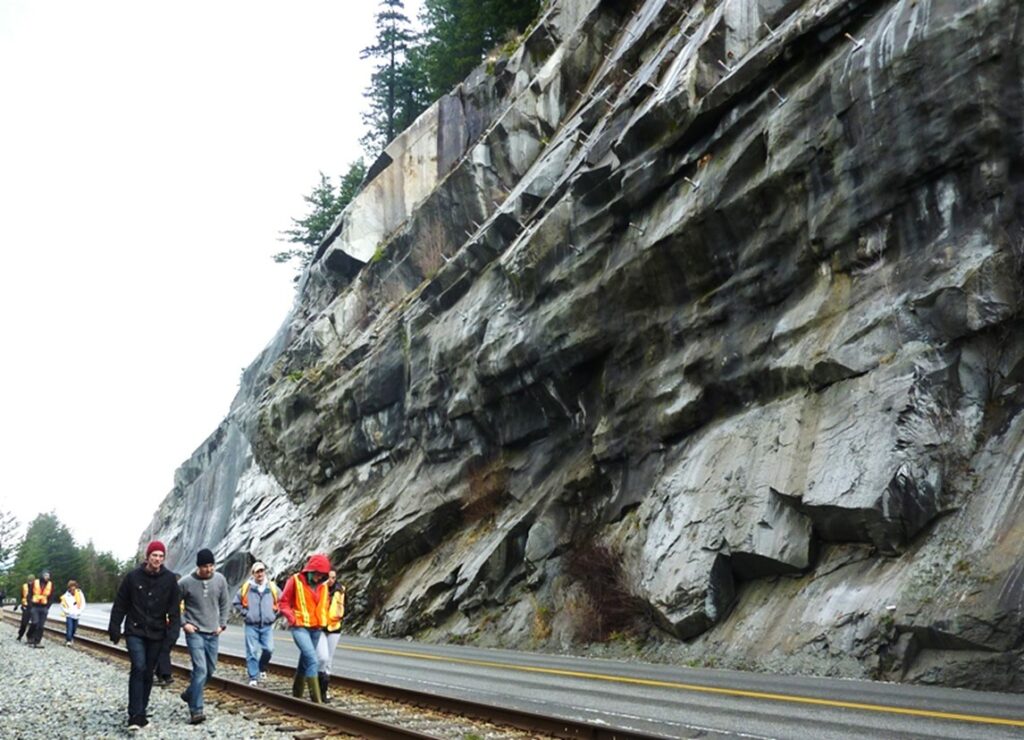
Rock Avalanche
If a rock slide starts moving quickly (m/s) the rock is likely to break into many small pieces, and at that point it can become a rock avalanche, in which the large and small fragments of rock move in a fluid manner supported by cushion of air within and beneath the moving mass. The 1965 Hope Slide (Figure 5.0.1) was a rock avalanche, as was the famous 1903 Frank Slide in southwestern Alberta. The 2010 slide at Mt Meager (west of Lillooet), also a rock avalanche (Figure 5.2.4).[2]
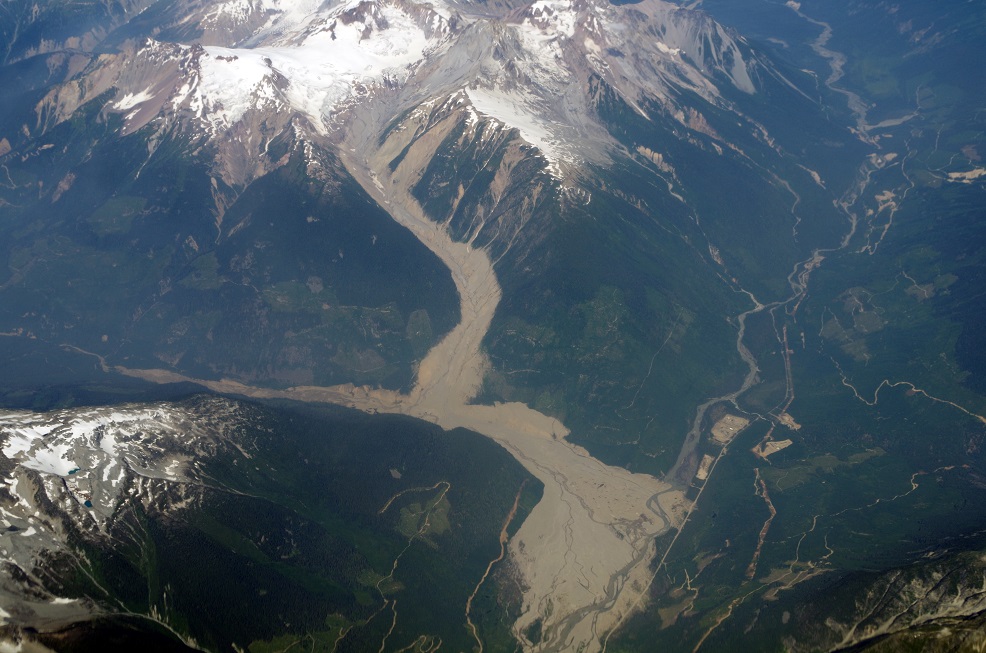
Creep
The very slow—mm/y to cm/y—movement of soil or other unconsolidated material on a slope is known as creep. Creep, which normally only affects the upper several centimetres of loose material, is typically a type of very slow flow, but in some cases sliding may take place. Creep can be facilitated by freezing and thawing, because, as shown on Figure 5.2.5, particles get lifted perpendicular to the surface by the growth of ice crystals within the soil, and are then let down vertically by gravity when the ice melts. The same effect can be produced by frequent wetting and drying of the soil.
Creep is most noticeable on moderate to steep slopes where trees, fence posts or gravestones are consistently leaning in a downhill direction (Figure 5.2.6). In the case of trees, they try to correct their lean by growing upright, and this leads to a curved lower trunk known as a “pistol butt” (or “j-shaped tree trunk”). Creep can take place on nearly flat surfaces.
Slump
Slump is a type of slide (movement as a mass), that takes place within thick unconsolidated deposits (typically greater than 10 m). Slumps involve movement along a curved surface, with downward motion near to the top and outward motion towards the bottom (Figure 5.2.7). They are typically caused by an excess of water within the materials on a steep slope.
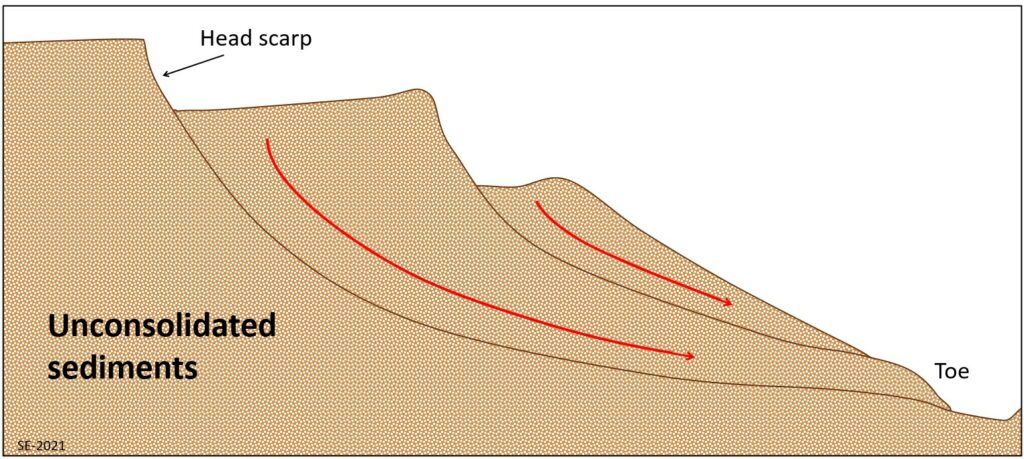
An example of a slump in the Lethbridge area, Alberta, is shown on Figure 5.2.8. This feature has likely been active for many decades, and moves a little more whenever there are heavy spring rains and significant snow-melt runoff. The toe of the slump is failing because it has been eroded by the small stream at the bottom.

Mud Flows and Debris Flows
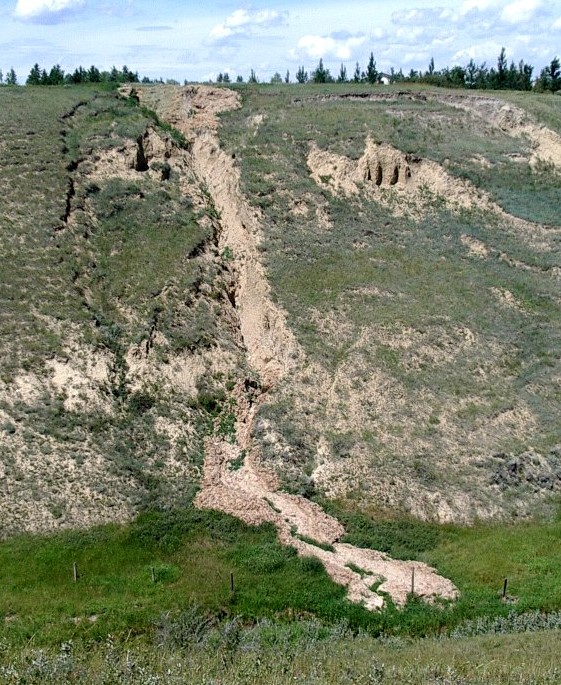
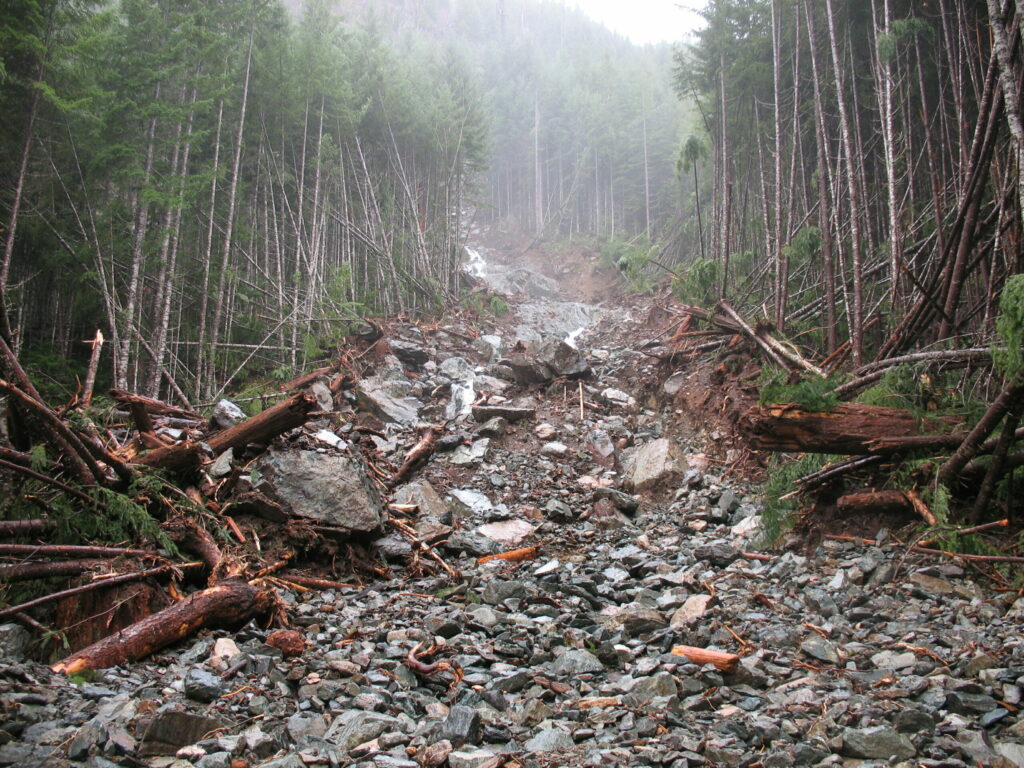
Exercise 5.2 Classifying Slope Failures
The four photos below show some of the different types of slope failures described above. Try to identify the different types, and in each case provide some criteria for why you made that choice.
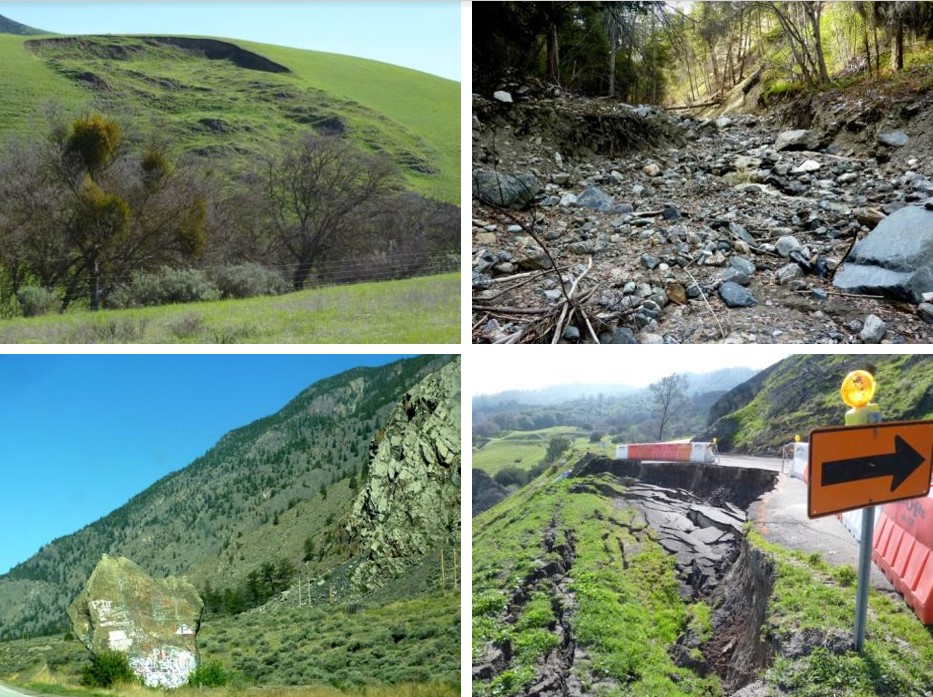
Exercise answers are provided Appendix 2.
As already noted, to understand a slope failure we need to be able to determine what type of material moved, what type (or types) of motion were involved, and how quickly it moved. The type of motion is the most important of these, and so Figure 5.2.11 is provided here to help you clearly understand how things moved in different types of slope failure.
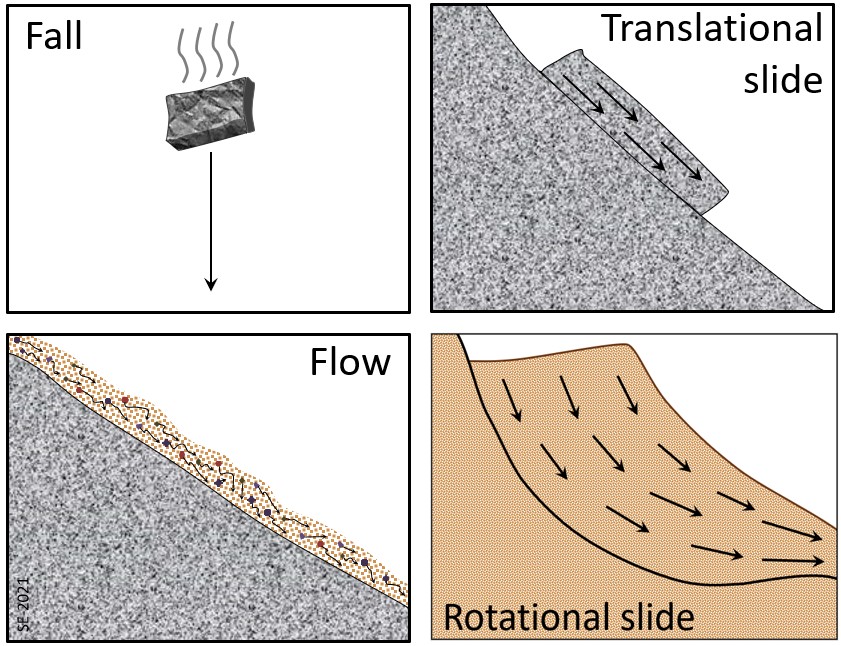
Exercise 5.3 Slope Failure Field Trip
It’s time to get outside and look for evidence of slope failure close to home. No matter where you live, even on the flattest plain, there is likely to be some kind of natural slope failure nearby. Venture to some sloping terrain, such as a valley eroded by a stream, a road embankment, a gently sloping cemetery, and look for evidence that there has been some down-slope movement.
When you find something, try to answer the following question:
- What has failed (is it loose sediments or solid rock)?
- How has it failed (slide or flow)?
- How quickly did the material move?
- How long ago did it happen (or is it still happening)?
- What is the risk for future failure at this location?
Box 5.1 The November 2020 Mass Wasting Events at Elliot Creek, BC
On December 10th, 2020 helicopter pilot Bastian Fleury was flying over Elliot Creek in southwestern BC when he noticed that the creek valley had been devastated by a massive debris flow. Fleury was the first person to be aware of this event, which had actually taken place on November 27th (based on some small (M4) seismic events from that location). There is no evidence that anyone was in the area at the time and there was little damage to human infrastructure. Later flights by Fleury and others confirmed that the event had started with a rock slide at the upper end of Elliot Lake, and continued for 14 km down Elliot Creek and then another 10 km along the Southgate River to the ocean at Bute Inlet. This mass wasting event is expected to have a significant impact on the salmon (and the salmon fishery) in the waters of Bute Inlet.[3]
Media Attributions
- Figure 5.2.1 Photos by Steven Earle, CC BY 4.0
- Figure 5.2.2 Image from Google Earth.
- Figure 5.2.3 Photo by Steven Earle, CC BY 4.0
- Figure 5.2.4 2010 Mount Meager Landslide by Tim Gage, 2014, CC BY SA 2.0, via Wikimedia Commons, https://commons.wikimedia.org/wiki/File:2010_Mount_Meager_landslide.jpg
- Figure 5.2.5 Photo by Steven Earle, CC BY 4.0
- Figure 5.2.6 Steven Earle, CC BY 4.0
- Figure 5.2.7 Photo by Steven Earle, CC BY 4.0
- Figure 5.2.8 Photo by Steven Earle, CC BY 4.0
- Figure 5.2.9 Photo by Steven Earle, CC BY 4.0
- Figure 5.2.10 Photo by Steven Earle, CC BY 4.0
- Figure 5.2.11 Steven Earle, CC BY 4.0
- Figure 5.2.12 Steven Earle, CC BY 4.0. All of the photographs are public domain and have been provided by 49North Helicopters, https://49northhelicopters.com; satellite imagery is from Google Earth.
- Kalenchuk, K. S., Hutchinson, D. J., Diederichs, M. S., and Moore, D. (2012). Downie Slide, British Columbia, Canada. In Clague, J. J. & D. Stead (Eds.), Landslides: Types, Mechanisms and Modeling (p. 345-358). Cambridge University Press. ↵
- Guthrie, R. et al., (2012). The 6 August 2010 Mount Meager rock slide-debris flow, Coast Mountains, British Columbia: characteristics, dynamics, and implications for hazard and risk assessment. Natural Hazards Earth System Science, 12(5), 1277–1294, https://doi.org/10.5194/nhess-12-1277-2012. ↵
- Stewart, B. (2021, June 23). Scientists, Homalco First Nation team up to probe massive B.C. landslide — and its impact on salmon. CBC News. https://www.cbc.ca/news/canada/british-columbia/bc-landslide-science-tsunami-earthquake-1.6075933 ↵

